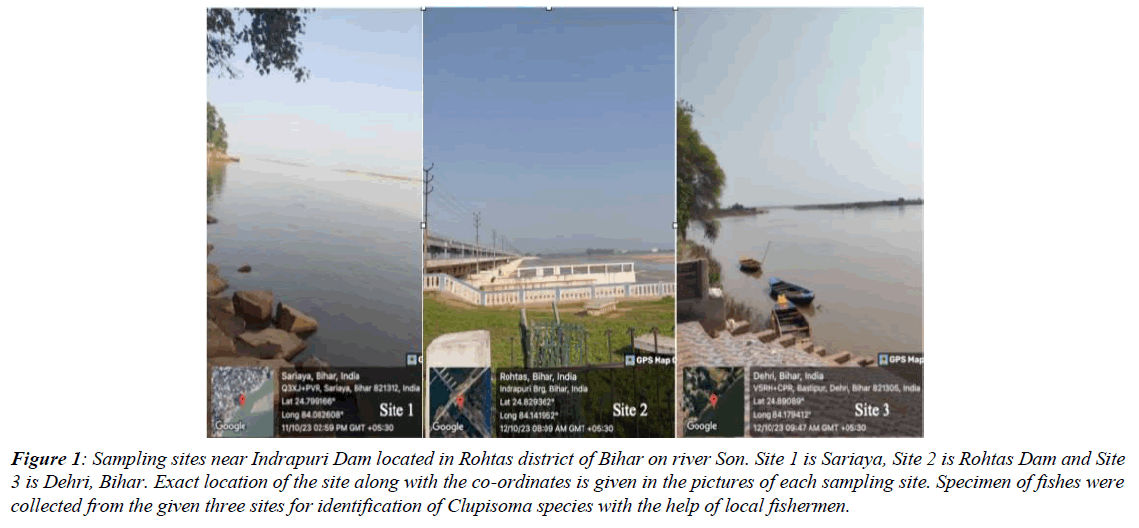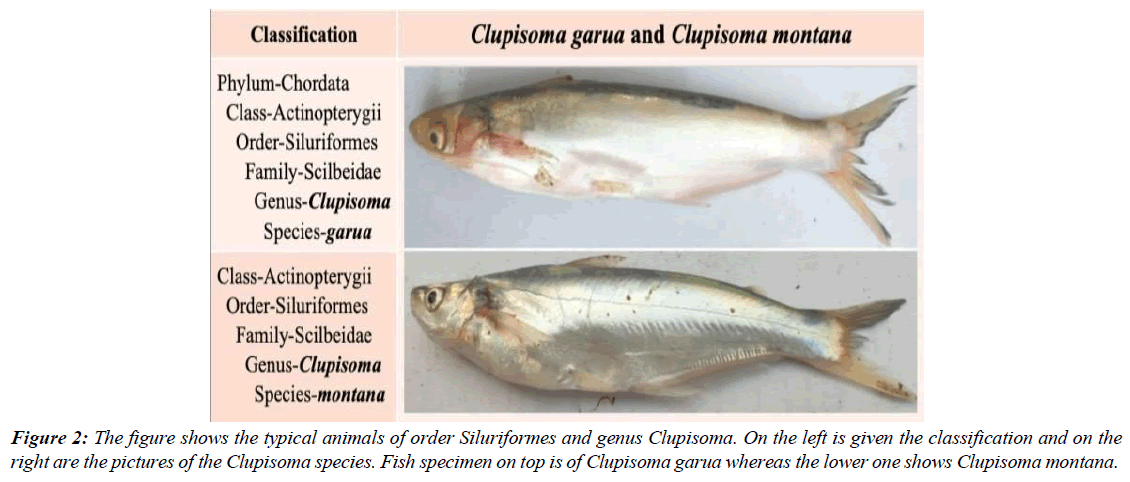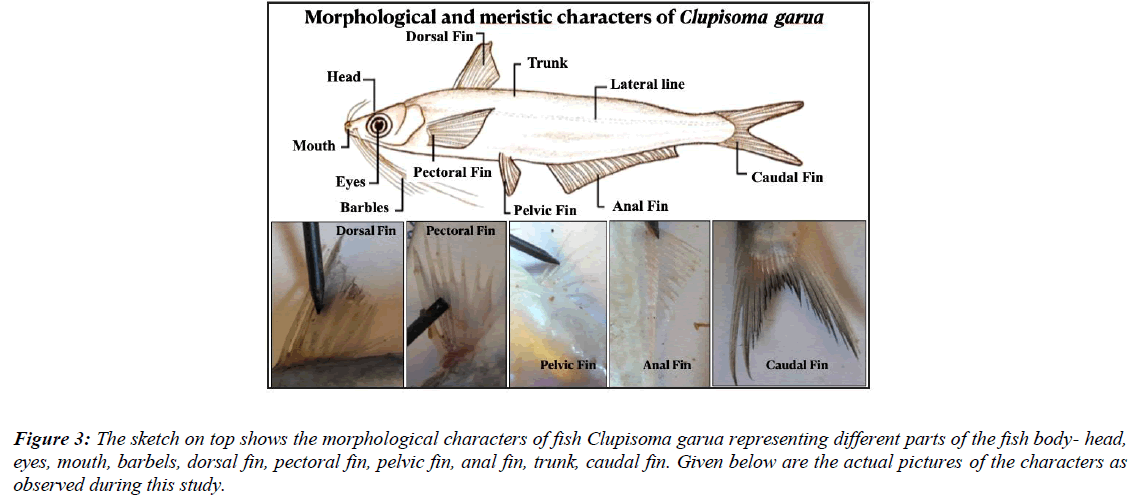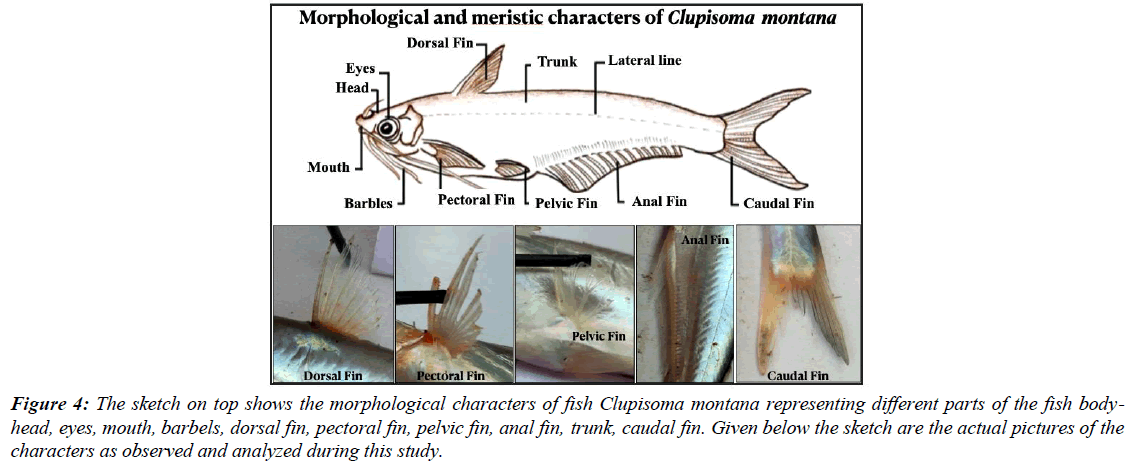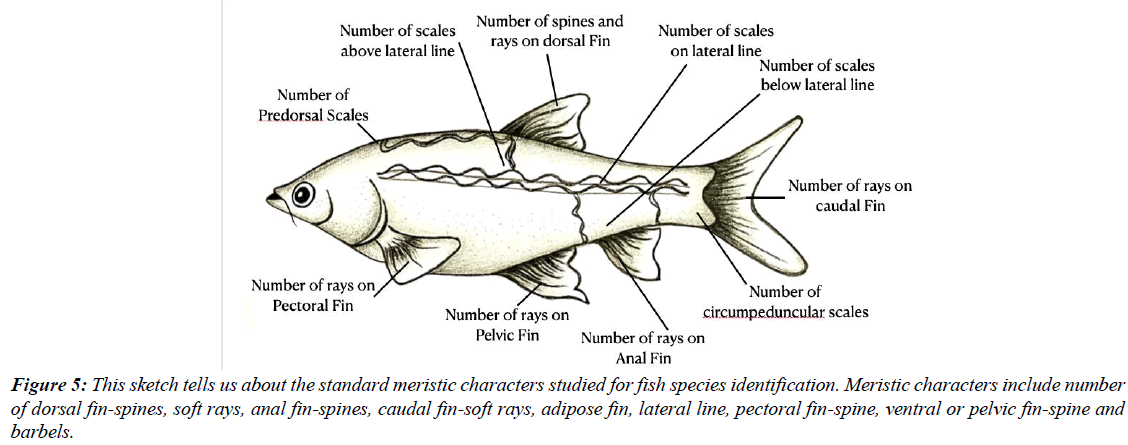Research Article - Journal of Fisheries Research (2023) Volume 7, Issue 3
Identification Study of freshwater fish Clupisoma garua and Clupisoma montana
Babita Sharma1*, Ambiya khatoon1, Kritika Pandey1, Ayush Kumar1, Bharat Bhushan1, Puja kumari1, Manoj Kumar Jaiswal2
1Department of Zoology, Patna Science College, Patna University, Patna, Bihar
2Department of Zoology, C. M. P. Degree College, University of Allahabad, Prayagraj (U.P)
- *Corresponding Author:
- Babita Sharma
Department of Zoology
Patna Science College
Patna University, Patna, Bihar
E-mail: babita2005@gmail.com
Received: 25-May-2023, Manuscript No. aajfr-22-102505; Editor assigned: 29-May-2023, PreQC No. aajfr-22-102505(PQ); Reviewed: 16-Jun-2023, QC No. aajfr-22-102505; Revised: 19-Jun-2023, Manuscript No. aajfr-22-10250 (R); Published: 27-Jun-2023, DOI: 10.35841/aajfr-7.3.147
Citation: Sharma B, khatoon A, Jaiswal MK etc. Identification study of freshwater fish Clupisoma garua and Clupisoma montana. J Fish Res. 2023;7(3):147
Abstract
Clupisoma garua and Clupisoma montana are freshwater fish species belonging to the family Schilbeidae. These fish species have notable ecological and economic significance, but identification and distribution data remain insufficient. In this study, we aim to accurately identify and distinguish between two freshwater fish species - Clupisoma garua and Clupisoma montana, which are widely distributed in various rivers of Asia. A comprehensive investigation of their morphological, meristic, morphometric, descriptive characteristics was performed to establish distinguishable features for efficient identification and classification. Meticulous field sampling was conducted to collect specimens of both species from the Indrapuri dam. The morphological analyses focused on the external features of the specimens, including color patterns, body shape, and fins. With the application of meristic characterization, we examined the countable traits such as the number of fin rays, lateral line scales, and vertebrae. Morphometric examinations were employed to quantify the overall dimensions and proportions of the specimens, analyzing distances and ratios between various anatomical landmarks. Our findings revealed key differences in the morphology, meristic, and morphometric characteristics of Clupisoma garua and Clupisoma montana, allowing us to define diagnostic features for each species. The comprehensive identification framework developed in this study provides a valuable tool for the scientific community, fisheries management, and conservation organizations. By accurately identifying and classifying these species, we aim to enhance the understanding of their ecology and contribute to the sustainable management of freshwater fish biodiversity.
Keywords
Clupisoma garua (C. garua), Clupisoma montana (C. montana), Morphological Characters, Morphometric Characters, Meristic Characters, and Descriptive Characters
Introduction
Freshwater fish are a vital component of aquatic ecosystems and play a crucial role in human society as sources of food and income generation. Proper identification of these species is a critical aspect of fisheries management, conservation and scientific research. This paper presents a comprehensive study of the identification of two freshwater fish species, Clupisoma garua and Clupisoma montana, found in river systems of Asia. Numerous studies have investigated freshwater fish species and their distribution, while simultaneously attempting to refine protocols for their identification [1-3]. However, detailed comparative studies on Clupisoma garua and Clupisoma montana have not been exclusively undertaken and their taxonomic positions and morphological features are often ambiguous [4]. Our work aims to provide a comprehensive overview of these two species in terms of their morphological, morphometric, meristic and descriptive characteristics. Clupisoma garua, commonly known as the silver garua or garua catfish, is a species of catfish that belongs to the family Schilbeide and is found in parts of South and Southeast Asia [2,5]. This slender fish, with its elongated body and cylindrical cross-section, is known to inhabit larger rivers, preferring areas with sandy or rocky substrates [6,7]. Whereas, Clupisoma montana, also referred to as the mountain catfish, is primarily restricted to the upper and central regions of the Ganges and Brahmaputra basins. It is found primarily in India, Nepal, Bhutan, and Bangladesh [2,3]. These two species are morphologically similar and often confused with each other due to their overlapping geographic ranges and shared habitat preferences [2,4], resulting in an urgent need for accurate identification and classification. Morphological examination forms the basis for fish identification, enabling the distinction of species by analysing their external structures and comparing them with taxonomic keys [8]. Counts and measurements of key morphological traits, such as fin rays, gill rakers, and gill slits, provide foundation data for distinguishing between two species. Furthermore, advancements in molecular biology techniques have provided tools to corroborate morphological data by comparing genetic markers, such as mitochondrial DNA and nuclear genes [9]. Combining molecular and morphological evidence not only increases the accuracy of species identification methods but also sheds light on their phylogenetic relationships and evolutionary history [10]. Considering the importance of these two freshwater fish species in terms of their ecological and economic values, their accurate identification is essential. This study fills the gap in understanding the differences of Clupisoma garua and Clupisoma montana, providing the conservationists, fisheries managers and scientists with a robust and comprehensive source of information that guides species identification. These findings will aid in the conservation efforts, correct population assessments and contribute to sustainable management strategy development for these freshwater organisms.
Methodology
Sampling Site
Fish specimen were collected from three different sites located near the Indrapuri dam, Rohtas, Bihar i.e. Sariaya, the Dam and Dehri. Co-ordinates of these locations are given in Figure 1. It is a significant water reservoir that plays crucial role in irrigation and water management of the region. It is 4th longest barrage in the world with a length of 1,407 meters and height of 44.94 meters [11] and is situated on river Son which is a major tributary of river Ganges [12], and is known for its contribution to agricultural activities and the overall socio-economics development of the area. Fishes C. montana and C. garua were caught by local fisherman of the above mentioned sites. The reason to study biodiversity of Indrapuri dam is driven by the scarcity of existing research conducted on this particular area. The dam is situated in a relatively undisturbed area with limited human interference, which allows undisturbed natural habitat for fish populations to thrive. We found both the fishes in the dam area but these two were not available in local markets of Patna.
Figure 1: Sampling sites near Indrapuri Dam located in Rohtas district of Bihar on river Son. Site 1 is Sariaya, Site 2 is Rohtas Dam and Site 3 is Dehri, Bihar. Exact location of the site along with the co-ordinates is given in the pictures of each sampling site. Specimen of fishes were collected from the given three sites for identification of Clupisoma species with the help of local fishermen.
Sample collection
Fish species C. montana and C. garua were selected for this identification study. Sample collection was done with the help of local fishermen. Being a migratory fish these fishes are rare to find hence data collection was done in batches. 5 fishes of each C. garua and C. montana were used for this work. Guidelines for the identification were taken from book of K. C. Jayaram (1977) [13]. Methods explained in this book helped us in identifying the fishes based on their physical characteristics, such as body shape, coloration, fin structure, and other distinctive features. Limited data is available on biology, behavior, and ecological roles of these two fish species and therefore this information is crucial for understanding the ecological dynamics within their aquatic ecosystems. This study will help in developing effective conservation strategies for managing cultures of these fishes (Figure 2).
Specimen 1
Clupisoma garua, often known as 'garua catfish,’ is a potamodromous (migratory) fish species that lives in both fresh and brackish water. The species is found mostly in major freshwater bodies found in parts of South and Southeast Asia. It is a bottom dwelling species often carried as shoals in fresh and brackish-water canals, rivers, streams, lakes, reservoirs and swamplands. It is omnivore by nature feeding on small invertebrates and plants along river borders [14].
Specimen 2
Clupisoma montana also known as 'mountain river catfish’ is primarily restricted to the upper and central regions of the Ganges and Brahmaputra basins, occurring primarily in India, Nepal, Bhutan, and Bangladesh. The body of C. montana is elongated and slender, with a silvery-gray coloration and a series of dark horizontal stripes along its sides. It possesses sensory barbels around its mouth. These barbels are used to detect food and navigate in its environment effectively. It is omnivorous and feeds on small invertebrates, aquatic insects and organic debris playing crucial role in the ecosystem as a detritivore [15].
Classical methods of species identification
Following types of characters are important while studying a species for identification. Based on these characters one can identify a species that is of importance and needs conservation. Better identification also means better management and fish production (Table-1).
| S. No. | Characters | Abbreviation | Explanation |
|---|---|---|---|
| 1 | Total length of body | TL | It refers to the measurement of the fish from the tip of its snout or mouth to the end of its tail fin, including the caudal fin. |
| 2 | Standard length of body | SL | It refers to distance from the tip of the fish snout or mouth to the end of its vertebral column, excluding the caudal fin. |
| 3 | Depth of body | BD | It refers to the vertical measurement of the fish body from its ventral surface to its dorsal surface at its widest point. |
| 4 | Head length | HL | It refers to the measurement of fish head from tip of its snout or mouth to back of its gill cover or posterior margin of its eye socket. |
| 5 | Eye diameter | ED | It represents the distance from one side of the eye to the opposite side, passing through the center of the eyeball. |
| 6 | Dorsal fin length | DFL | It refers to the measurement of the dorsal fin from its base to the tip. |
| 7 | Pectoral fin length | P1FL | It refers to the measurement of the pectoral fin from its base to the outermost tip. |
| 8 | Anal fin length | AFL | It refers to the measurement of the anal fin from its base to its outermost tip. |
| 9 | Caudal fin length | CFL | It refers to the measurement of the caudal fin, measured from the base of the caudal fin, where it attaches to the body, to the outermost point of the fin. |
| 10 | Dorsal fin spines | DFS | It refers to the measurement of the length of each individual spine from its base to the tip. |
| 11 | Pectoral fin spines | P1FS | It refers to the measurement of the length of each individual spine from its base to the tip. |
| 12 | Ventral or Pelvic fin spine | P2FS | It refers to the measurement of the length of each individual spine from its base to the tip. |
| 13 | Anal fin- spines | AFS | The measurement usually taken along the axis of the spine, which corresponds to the straight line running from the point of attachment on fish’s body to outermost tip of spine. |
| 14 | Soft rays | SR | Using a ruler or calipers each soft rays is measured from the base of the ray to the desired endpoint. |
| 15 | Barbels | B | Number of barbels are counted taking care. If there are multiple pairs, count each pair separately. |
Table-1: This table represents different characters observed for the study of the Clupisoma fishes. Values given in column 2 are the characters that were used for identification. Column 3 shows standard abbreviations of the characters and Column 4 explains the definitions of the characters given in column 1. All the characters and their definitions are explained in the figure below pictorially.
Morphological characters
It refers to the physical features of an organism that are related to its form, structure and appearance. These characteristics include aspects such as body shape, size, coloration, presence of appendages or organs and other observable physical attributes [16].
Morphometric characters
It refers to the quantitative measurements which are measured by various tools and techniques, such as calipers, rulers, or digital imaging software [17].
Meristic Characters
Meristic Characters are quantitative traits that describe the countable features of an organism.
Number of fin rays: Different species have specific number of rays in their fins (dorsal fin, pectoral fins, and anal fin). These numbers can vary between individuals and populations, but they are typically consistent within a species.
Number of vertebrae: The number of vertebrae is another meristic characteristic used to differentiate between fish species. This count can vary between species and can be used as an identification feature.
Number of gill rakers: Different species have a specific number of gill rakers on their gill arches. These structures help filter food particles from the water.
Number of scales: The number of scales along the lateral line or on the body is another meristic character that can vary between individuals and populations. These meristic characteristics, along with the morphological characteristics mentioned earlier, help scientists and researchers differentiate between and understand the unique traits of each species [16].
Descriptive characters
These characters are used to describe the physical appearance, coloration, shape of the body, presence or absence of certain fins, color patterns, scales, and other distinctive features [16, 17]. Table given below explains all the types of characters that were used for identification of C. garua and C. montana.
Results and Discussion
Morphological characters
Morphological characteristics refer to the physical traits and features of an organism that are related to its form, structure, and appearance. These characteristics can include aspects such as body shape, size, coloration, presence of appendages or organs, and other observable physical attributes. Morphologically, these species exhibit notable differences. C. garua possesses a slender body shape, which is elongated and laterally compressed; additionally it tends to display a bluish- gray coloration on its dorsal side. It has a pointed snout and a relatively long, forked tail. Figure 3 explains the major morphological characters examined for this study [18].
Figure 3: The sketch on top shows the morphological characters of fish Clupisoma garua representing different parts of the fish body- head, eyes, mouth, barbels, dorsal fin, pectoral fin, pelvic fin, anal fin, trunk, caudal fin. Given below are the actual pictures of the characters as observed during this study.
In contrast, Clupisoma montana features a more robust body structure, with a rounded snout and a shorter, less forked tail and it often characterized by a brownish-gray hue. These differences contribute to the visual distinctiveness between the two species and aid in their taxonomic identification (Figure 4) [19].
Figure 4: The sketch on top shows the morphological characters of fish Clupisoma montana representing different parts of the fish body- head, eyes, mouth, barbels, dorsal fin, pectoral fin, pelvic fin, anal fin, trunk, caudal fin. Given below the sketch are the actual pictures of the characters as observed and analyzed during this study.
Morphometric characters
Size and shape of an organism's body or its specific parts [20]. These measurements are obtained through various techniques, such as calipers, rulers, or digital imaging software. Morphometric analysis allows for the objective comparison and analysis of the variation in size and shape among individuals or populations. It can provide insights into population dynamics, evolutionary relationships, and ecological adaptations within a species or group of organisms (Table-2) [21].
| S. No | Morphometric characters | Abbreviation | Clupisoma garua | Clupisoma montana |
|---|---|---|---|---|
| 1 | Total length of body | TL | 21.1 cm | 19.00 cm |
| 2 | Standard length of body | SL | 72.51 % of TL | 73.68 % of TL |
| 3 | Depth of body | BD | 27.01 % of TL | 23.68 % of TL |
| 4 | Head length | HL | 16.11 % of TL | 16.31 % of TL |
| 5 | Eye diameter | ED | 23.52 % of HL | 22.58 % of HL |
| 6 | Dorsal fin length | DFL | 11.84 % of TL | 12.10 % of TL |
| 7 | Pectoral fin length | P1FL | 12.79 % of TL | 13.15 % of TL |
| 8 | Pelvic fin length | P2FL | 7.58 % of TL | 8.42 % of TL |
| 9 | Anal fin length | AFL | 23.69 % of TL | 28.94 % of TL |
| 10 | Caudal fin length | CFL | 18.48 % of TL | 22.63 % of TL |
Table-2: This table shows the different morphometric characters of the Clupisoma species as measured by the standard methods. The morphometric characters are – Total Length of the Body(TL), Standard Length of the Body(SL), Depth of body(bd), Head Length(HL), Eye Diameter(ED), Dorsal Fin Length(DFL), Pectoral Fin Length(P1FL), Pelvic Fin Length(P2FL), Anal Fin Length(AFL), Caudal Fin Length(CFL).
Meristic characters
Meristic characters are quantitative traits that are counted or enumerated and provide information about the number of specific features or structures in an organism. These characteristics include counts of features such as fin rays, scales, vertebrae, or other segmented structures like myotomes. By analyzing meristic characters, we can compare and differentiate individuals or populations. Meristic characters vary in count in different species, which can help in species identification, population assessment and understanding genetic diversity of a species (Figure 5, Table-3) [22].
Figure 5: This sketch tells us about the standard meristic characters studied for fish species identification. Meristic characters include number of dorsal fin-spines, soft rays, anal fin-spines, caudal fin-soft rays, adipose fin, lateral line, pectoral fin-spine, ventral or pelvic fin-spine and barbels.
| S.No. | Meristic characters | Clupisoma garua | Clupisoma montana |
|---|---|---|---|
| 1 | Adipose fin | Absent | Present, very small |
| 2 | Lateral line | Present | Present |
| 3 | Dorsal fin- spines | 1-2 , slender | 1 |
| 4 | Soft rays | 6-7 (4 branched) | 7 |
| 5 | Pectoral fin- spines | 1, serrated internally | 1 |
| 6 | Soft rays | 11-Sep | 10-Sep |
| 7 | Ventral or Pelvic fin- spine | 0 | 0 |
| 8 | Soft rays | 6 | 5 |
| 9 | Anal fin- spines | 3-Feb | 1 |
| 10 | Soft rays | 27-29 | 30-34 |
| 11 | Caudal fin- soft rays | 16-18 | 19-20 |
| 12 | Barbels | 4 pairs (2 pair mandibular and 1 pair each of maxillary and nasal). | 4 pairs (2 pair mandibular and 1 pair each of maxillary and nasal). |
Table-3: Meristic characters of both C. garua and C. montana are shown in the table below. There are some differences in the numbers of dorsal fin-spines, soft rays, anal fin-spines, caudal fin-soft rays and no differences found in rest of the characters adipose fin, lateral line, pectoral fin-spine, ventral or pelvic fin-spine, barbels as shown in the table.
Descriptive characters
Descriptive characters of fish refer to the qualitative traits or features used to describe the physical appearance, coloration, body shape, and other observable characteristics of fish species. These traits provide important information for species identification, taxonomy, and ecological studies. Descriptive characters can include details about the shape of the body, presence or absence of certain fins, color patterns, scales, and other distinctive features (Table-4) [23-25].
| S.No. | Descriptive characters | Clupisoma garua | Clupisoma montana |
|---|---|---|---|
| 1 | Body shape | Elongated and laterally flattened | Robust body structure |
| 2 | Mouth | Wide and Sub terminal | Sub terminal |
| 3 | Eyes | Large, darker with circular adipose eyelids. | Small, little light color |
| 4 | Caudal fin | Deeply forked tail | Less forked tail |
| 5 | Body color | Silvery grey-green back and whitish or silvery on sides and belly. Light greenish on dorsal and caudal fin, light reddish on pectoral, pelvic, mouth and head. Silvery on anal fin. | Grayish above and whitish silvery on sides and belly. Light reddish on all fins and bluish on mouth and head. |
| 6 | IUCN status | Least concern. Threatened in West Bengal. Endangered in Bangladesh. Vulnerable in India. | Least concern |
Table-4: Table presents the descriptive characters of C. garua and C. montana showing the body shape, mouth type, eyes, types of caudal fin, body color, and IUCN status of the fishes.
Conclusion
Freshwater ecosystems support a rich diversity of fish species, which contribute immensely to the ecological balance and provide vital resources for human consumption and recreational activities. The identification study of freshwater fish C. garua and C. montana using methods such as morphological, morphometric, meristic and descriptive characters near Indrapuri Dam area has provided valuable insights into the taxonomic classification and characteristics of these two species. It allowed us to differentiate between C. garua and C. montana based on distinct morphological traits. Meristic analysis that involved counting specific anatomical features such as the number of fin rays, scales, and vertebrae provided further supporting information. Similarly, morphometric analysis, which focused on quantitative measurements of various body parts, provided a more precise and objective means of identification. By examining measurements such as body length, head length, and fin dimensions, we were able to identify significant differences in size, counts and proportions between the two species. Lastly, the descriptive character analysis involved detailed descriptions of unique features, behavior, and habitat preferences which enhanced our understanding of the ecological niche and behavior of these fish species, aiding in their accurate identification. Collectively, all these methods utilized in the identification study of C. garua and C. montana have contributed to our knowledge of their taxonomic classification and distinguishing characteristics. We are reporting detailed differences between the two species for the first time here. Such studies are crucial for effective conservation and management of freshwater fish populations, as well as for the overall ecological assessment of aquatic ecosystems. Future research can build upon these findings to explore further aspects of their biology and ecology, contributing to the preservation and sustainable management of freshwater fish species in similar habitats.
Acknowledgements
Authors thank Department of Zoology, Patna Science College, Patna University for continuous support and encouragement.
Conflict of Interest
Authors declare no conflict of interest.
References
- Nelson JS, Grande TC, Wilson MVH. Fishes of the World. 5th Edition, John Wiley & Sons, Inc, New York. 2016;1-733.
- Ng HH, Kottelat M, Musikasinthorn P. The Clupisoma (Siluriformes: Ailiidae) of Myanmar, with descriptions of two new species. Ichthyological Exploration of Freshwaters. 2016;27(3),257-268.
- Khatiwada J, Shrestha B, Shrestha S, et al. Annotated checklist of fishes of Nepal based on morphometric and genetic examination. ZooKeys. 2020; 960,13-64.
- Chu XL. A review of the catfish genus Clupisoma (Siluriformes: Schilbidae) from China, with the description of a new species. Japanese Journal of Ichthyology. 1984;31(3),257-65.
- Chakrabarty P. The ailiid catfishes (Siluriformes: Ailiidae) of Asia. Zootaxa. 2012;3434:51-63.
- Talwar PK, Jhingran AG. Inland fishes of India and adjacent countries. CRC press. 1991;2(12):1-541.
- Ahmed KKU. Handbook on fishes of Indian waters. Zoological Survey of India, Kolkata. 2010;1-430.
- Rohde K. Taxonomy: A new genus and new species of Schilbeidae. Fish & Fisheries. 2016;18(5), 875-885.
- Ferri E, Barbuto M, Bain O, et al. Integrated taxonomy: Traditional approach and DNA barcoding for the identification of filarioid worms and related parasites (Nematoda). Frontiers in Zoo. 2009;6:1-12.
- Ferreira MFP, Pazian MF, Hanner R, et al. A new species of Characidium (Characiformes: Crenuchidae) from coastal basins in the Atlantic Rainforest of eastern Brazil, with phylogenetic and phylogeographic insights into the Characidium alipioi species group. Neotropical Ichthyology. 2019;17(2):e180121.
- Arvind Kumar Rai, Farah Diba, and Biswajit Paul. (2013). A study on the seasonal variations of different physico chemical water quality parameters of Indrapuri Dam Rohtas district Bihar. Int J Environ Sci. 2013;2(3):125-129.
- Rai PK, Mishra VN, Mohan K. A study of morphometric evaluation of the Son basin, India using geospatial approach. Remote Sens Appl Soc Environ. 2017;7:9-20.
- Jayaram KC. Aid to the identification of siluroid fishes of India, Burma, Sri Lanka, Pakistan and Bangladesh. 2. Siluridae, Schilbeidae, Pangasidae, Amblycipitidae, Akysidae. Rec Zoological Sur India. 1977;10:1-33.
- Verma J, Serajuddin M. Intra-specific and inter-generic phylogenetic relationships in endangered catfish (Clupisoma garua and Eutropiichthysvacha) of family schilbeidae. J Entomology & Zoo Studies. 2017;5:198-202.
- Froese R, Pauly D (Eds). Clupisoma montana. Fish Base 2021.
- Thakur K, Kumar R, Bhavna B. A review on freshwater fish diversity of India and concept of DNA barcoding in fish identification. Egyptian J Aq Bio & Fisheries. 2021;25(3):667-693.
- Makmur S, Arfiati D, Bintoro G, et al. Morphological, meristic characteristics and mtDNA analysis of Hampala Fish (Hampala macrolepidota Kuhl & Van Hasselt 1823) from Ranau lake, Indonesia. J Biodiversity and Environmental Sci (JBES). 2014;(5)2:447-455.
- Biswas I, Nagesh TS, Sajina AM, et al. Morphometric variations and meristic counts of Clupisoma garua: An approach for assessing stock structure in the river Ganga. J Exp Zool India. 2018;21(2):813-822.
- Ullah MR. A comprehensive impression on endangered Garua Bachcha, Clupisoma garua (Hamilton, 1822) from the habitats of Bangladesh: A review. Int J Zoology & Animal Bio. 2022;2(1).
- Masooda Z, Hawab N, Hassanc HU, et al. Study of some morphometric and meristic characteristics of Alepes vari (Cuvier, 1833) collected from the Arabian coast. Brazilian J Bio. 2022;21:84.
- Ahirwal SK, Singh J, Sarma K, et al. Morphometric characteristics, length-weight relationships, and condition factors of five indigenous fish species from the river Ganga in Bihar, India. J Applied Ichthyology. 2023.
- Hussain A, Qazi JI, Shakir HA, et al. Length-weight relationship, meristic and morphometric study of Clupisoma Naziri form the river Indus, Pakistan. Punjab Univ J Zool. 2009;24(1-2),41-47.
- Bhakta B, Sonia. (2020). Review on Clupisoma Garua (Hamilton, 1822), An inhabitant species in Inland open waters of India. Env Sci. 2020;5(1):25-29.
- India Biodiversity Portal. https://indiabiodiversity.org/species/show/232061
- India Biodiversity Portal. https://indiabiodiversity.org/species/show/232041
Indexed at, Google scholar, Cross ref
Indexed at, Google scholar, Cross ref
